Hemingway once said “There is nothing to writing. All you do is sit down at a typewriter and bleed.” But I don’t know that copywriters would agree with this. There are just so many factors to consider and details to remember for crafting stellar copy that rocks.
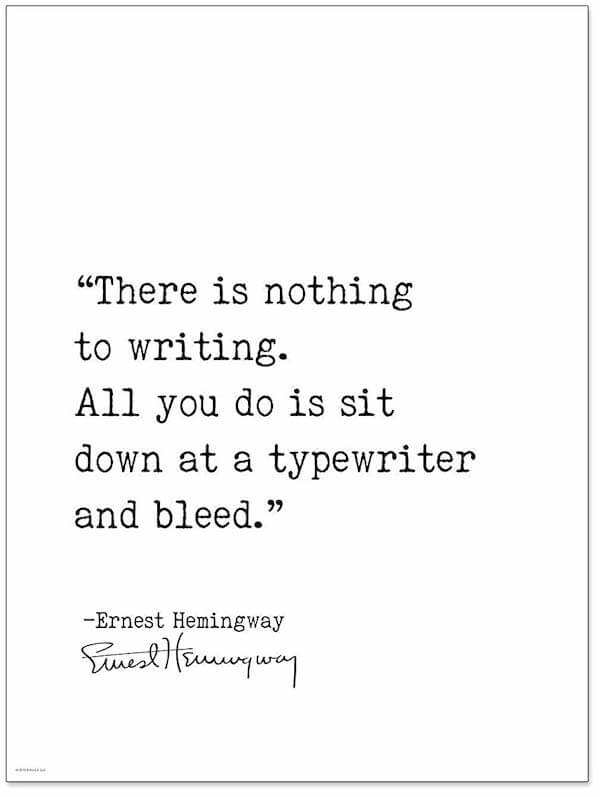
But lucky for you, I’ve gathered 21 common copywriting mistakes even experienced specialists make from time to time. Use it as a checklist whenever you need to write copy or review a draft!
21 copywriting mistakes to avoid for better marketing results
Below you’ll find a list of copywriting mistakes that are often all too easy or tempting to make. Some are minor while others can really impact your marketing results.
1. Not understanding the copy’s target
The most obvious yet often ignored mistake some writers still make:
They craft content in a way that makes sense to them, not the audience they need to engage. While it’s critical to know your product or service, there’s a difference between what you want to tell and what the reader wants to hear about it.
Ensure you know the buyer’s persona inside and out. A competent copywriter understands their needs, pains, motivations, frustrations, and possible objections because it helps craft compelling content that works.
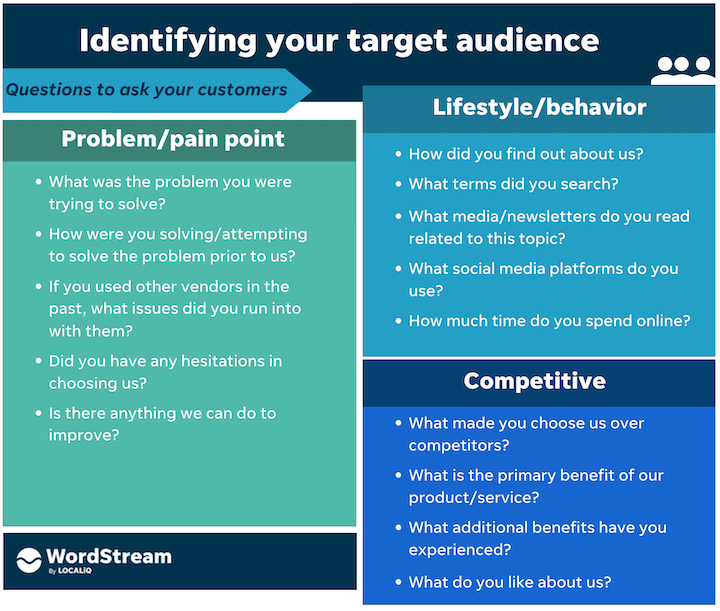
2. No problem to solve
Copywriting is about getting the audience to act. But to act, they need to understand the problem this action will help them solve. It’s wrong to assume that the reader knows it.
Outline the problem in your content. Remember the “What’s in there for me?” issue: When reading, a person looks for a clear answer to this question.
Example:
- Grab our marketing guide!
No problem to solve here; a reader doesn’t understand why they need to take this guide. - Grab our content guide to help you write persuasive marketing copy!
The reader understands what’s in there for them in your content.)
Here’s another Google Ad example that has the problem stated within the copy:
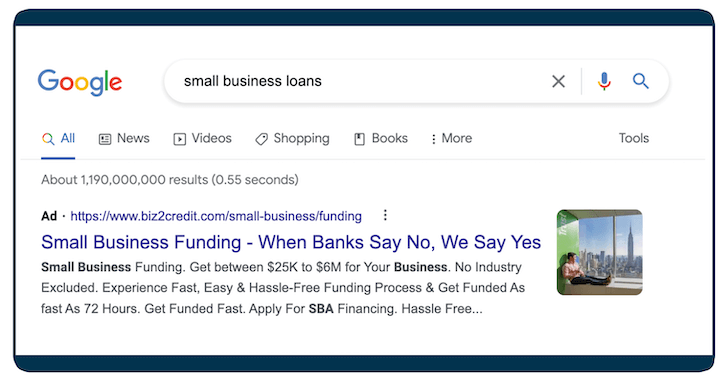
3. Wrong tone
The golden rule of copywriting: Follow the brand’s tone of voice when crafting all of your copy. If unable to capture that tone and stay consistent, you won’t hit the target market.
The tone of voice is about a brand’s values, philosophy, and attitude toward its audience. It determines the lexical items and sentence structure you’ll use in copies to communicate the message. It allows you to speak the same language as the audience and make them want to listen to you.
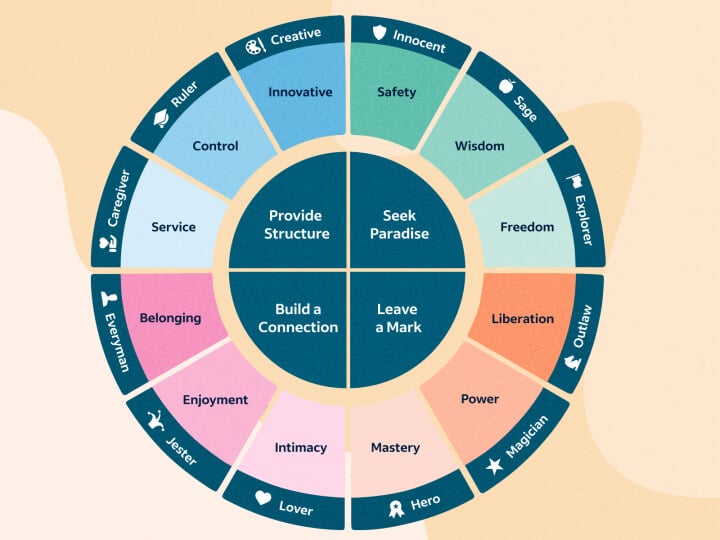
If your client doesn’t have a brand book or style guide describing their tone of voice, the minimum you can do is to read their previously published content to mirror their communication style in your writings.
4. Opening with boring generalizations
All too often, writers start out a blog post or marketing email with a generic absolute or boring generalization. For example:
- It’s not a secret that sugar harms our health.
- Everyone knows that smoking is dangerous.
Such claims convey no meaning or value. Why write it if it tells nothing new?
Anyone can create such generic content online. If you want to write compelling marketing copy, use interesting information backed up by statistics and research, quotes from influencers in the topic, or testimonials from customers.
Instead of the above, how about:
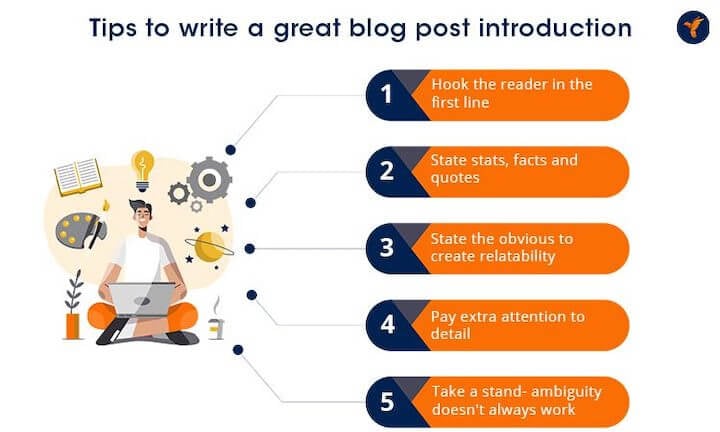
You can get more tips on how to write an introduction here.
5. Ignoring the audience’s motivation level
This mistake is about forgetting the sales funnel stage of your target reader. Before you can write effective ad copy, you need to know where they are:
- Have they already heard of your brand or product?
- Are they ready to purchase?
- Do they have any questions, doubts, or fears left that could hold them back from purchasing?
Here’s a great example of emotional ad copy that plays on the target audience’s doubt:

Bottom line: You need to understand how aware, skeptical, and motivated your reader is. It helps you choose the right copywriting technique and decide on proper calls to action for a copy.
6. Weak headlines and subheads
Not only is reading online 25% slower than from print, but users also don’t read but scan web copy. Headlines and subheads guide them through content and help them understand if it’s worth their time.
That’s why a good copywriter makes these two copy elements count.
Stellar headlines and subheads are short, specific, and relevant to the content. The element of emotional writing is also worth trying to grab attention, evoke curiosity or FOMO, and motivate users to keep reading.
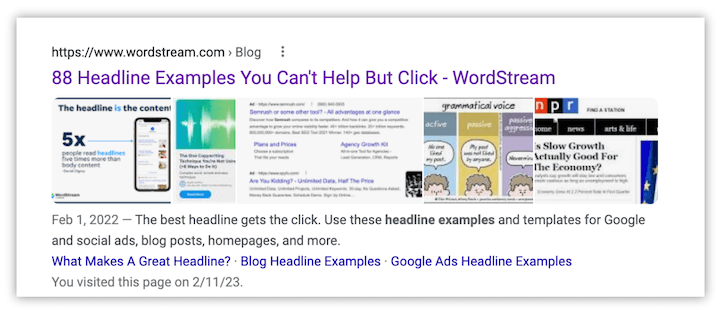
A headline example for a piece of content about headlines…
- Weak headline: Headlines to Try in Blog Posts, Ads, Emails, and More
- Strong headline: 88 Headline Examples you Can’t Help But Click
7. Lengthy sentences
Quick question: Can you find a period in this sentence?
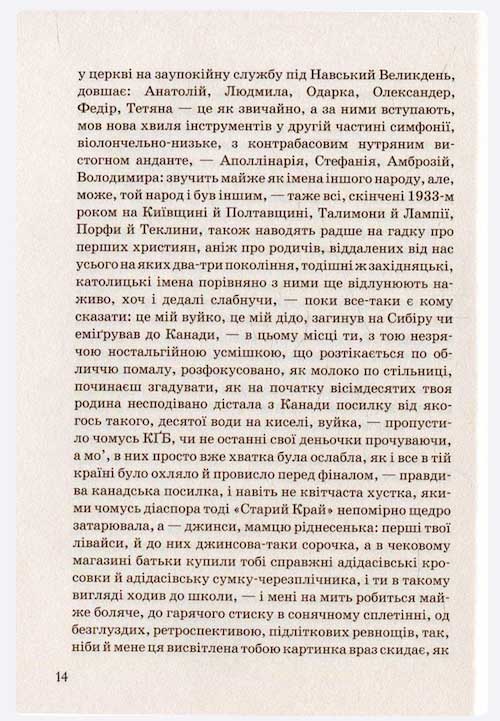
Unless you’re Oksana Zabuzhko, a Ukrainian novelist and essayist practicing super long sentences in her works (the above text is hers, from The Museum of Abandoned Secrets; you can find its audio version in English), avoid this practice.
Long sentences hurt your content’s usability and readability.
Remember that online users read only 20-28% of your text; focus on brevity.
8. Too formal
Copywriters know that web writing is conversational, and we speak to the audience in their language if we want to engage them.
But it’s challenging to strike a balance between conversational and casual. Afraid of losing this balance, some authors may sound too formal. They use complex sentences, academic language as if they write college essays, etc.
This is a mistake. It scares the reader away. The minimum you can practice to prevent this is to insert some conversational phrases like “you see” or “can’t” instead of “cannot” into your copies.

The ideal variant is to know and follow your brand’s tone of voice.
9. Too much jargon and buzzwords
Even though 21% of U.S. adults are illiterate, even those with high literacy skills won’t spend time reading your unnecessarily complex texts.
Niche jargon and buzzwords are a no-no when it comes to copywriting.
If a person has to take a dictionary to understand what you write, they’ll hardly enjoy and get engaged with your message. Readability testing tools can help you see whether you’re stuffing your marketing collateral with too many overcomplicated words.
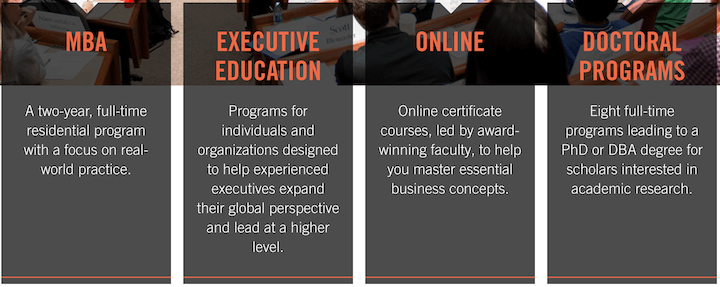
This copy is written for Harvard graduate school candidates. But does it use fancy words? Nope.
10. Ignoring mobile copywriting
Let’s face it: Most think of web-based copywriting when seeking a content specialist for their brands. But what about 4.32 billion internet users consuming your message from mobile?
When writing and formatting content, it’s critical to remember such a broad audience.
Design it for thumb-stopping visuals, short sentences, and easy-to-read font sizes for headlines. Eliminate unnecessary words, write up-to-point subheads, and consider short paragraph lengths.
11. Ignoring or overdoing SEO
When writing marketing copy, it’s also worth remembering how people will find it online. SEO writing elements will help search engines understand the context and rank your pages accordingly, but it’s essential to strike a balance here.
Focusing too much on optimizing your copy for keywords will do more harm than good. For Google, it will look like spam; for users, it will sound awkward and unnatural to read.
12. Too many modifiers
Adverbs and adjectives (especially beneficial ones) are powerful copywriting instruments. The trick is to know the limit.
Every modifier you use in content should serve for driving it. When overused, they make your copy wordy: Users can lose the core message you communicate.
- Too many: Add this beautiful and comfortable leather couch to your bedroom to give yourself a cozy corner to sit with a neutral yet stylish look that matches your room design (six modifiers).
- Just right: “This comfortable leather couch has a neutral color to match your room’s design. (three modifiers).
13. Too many intensifiers
Intensifiers are words we use to emphasize adverbs. There’s nothing wrong with them unless they become redundant, turning your copy into balderdash.
When used too often, intensifiers become nothing but fillers. They seem to be what Stephen King had in mind when saying, “The road to hell is paved with adverbs.” Most are -ly adverbs:
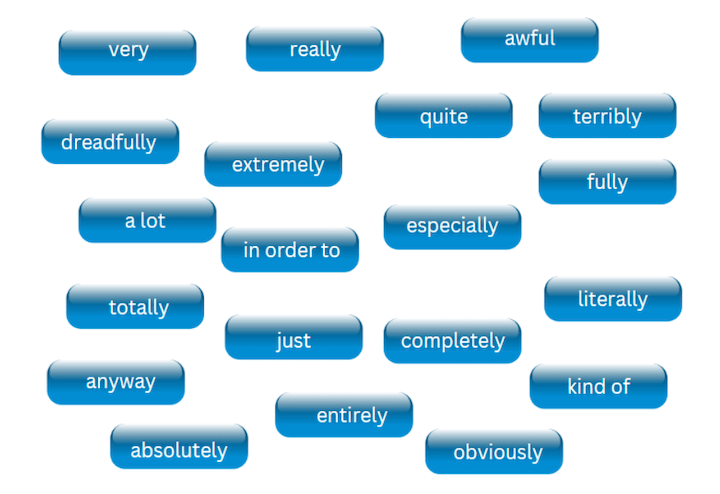
When possible, avoid such words in your content. You can always find an alternative power word that sounds stronger. Thus, “critical” or “essential” looks more confident than “very important.”
14. Boring words
Most writers have words or phrases they use too often. (Mine are “here,” “professional,” and “when it comes to”). When overused, they make your copy monotonous and dull to read.
Do your best to stop overusing certain words in writing. Analyze your copy, consider repeated phrases, and grab a thesaurus to change them and make your texts more engaging.
15. Weak formatting
As a rule, copywriters don’t think about their texts’ makeup. They follow the basic rules of web writing but ignore the content usability blunders that can make them lose readers.
These blunders are:
- Right align
- Hard-to-see subheads
- Wrong font size
- Complex text structure
- Large text fields
- Poor color-contrast ratio
- No paragraphs
When writing, please think of how your text will look online.
The ideal variant would be to know beforehand where the copy will go live. A page layout will help you see the website’s typography and format your text accordingly.
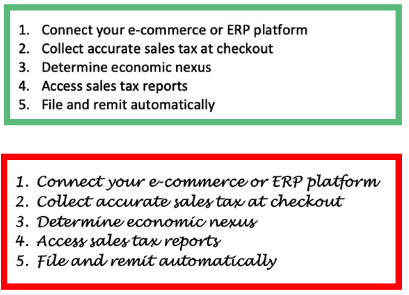
The readability of your font impacts the effectiveness of your copy! Learn more in our copywriting psychology post.
Formatting influences the reading experience and communication with the audience. Why lose readers simply because they can’t visually perceive your information?
16. Wrong use of emotional triggers
Copywriting is about triggering an emotional response from users, encouraging them to stay with a brand, and motivating them to act.
Knowing this, some authors use emotional triggers for evil, manipulating a person’s fear, uncertainty, and doubt (FUD) in their copies. While such manipulation can be a powerful sales tool, its overdose doesn’t work for building an ongoing customer relationship.
17. Wrong CTA, multiple CTAs, or no CTA at all
While copywriters know that a call to action (CTA) is a must, some aren’t sure how to make it effective.
A good CTA:
- Creates a sense of urgency;
- Tells the user what to do right after reading the copy;
- Gives the user a compelling reason to take that action.

A big mistake is to include several CTAs on one page, especially if they lead to different pages or ask to take a few various actions. Readers won’t understand what to do.
Give them the easiest possible path to the next step, and don’t limit yourself to boring “Buy now” or “Click here” options. Get creative with a CTA text, and don’t hesitate to use “I” and “me” pronouns. It makes your CTA sound more authentic and personalized.
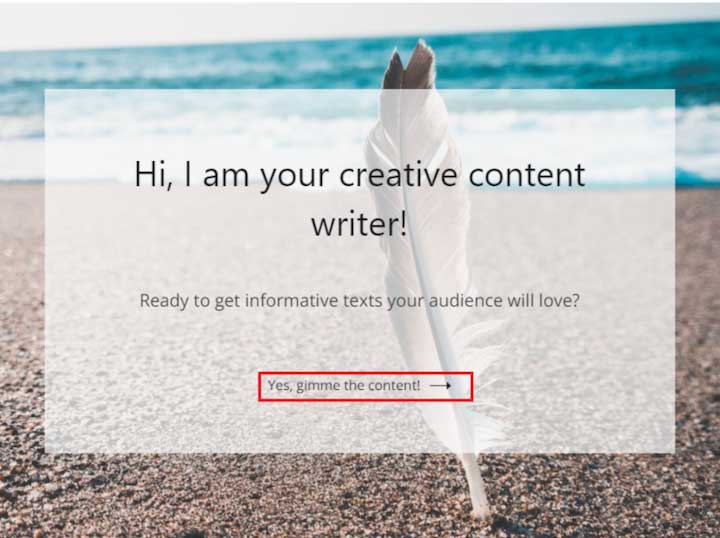
18. Too many colloquialisms or idioms
Colloquialisms (regional phrases) and idioms can add color and personality to your writing, but too many can be distracting with business copywriting.
Be careful with your “cold cucumbers” or “raining cats and dogs” as not all readers will understand them and you may not be able to convey the message you intend.
19. Too many features but no benefits
This is a common mistake of newbie copywriters and those lacking information about the buyer persona’s needs and pain points.
They describe the product features but don’t tell the audience how those features can benefit them, which is critical to do in marketing messaging: You should give readers a reason to buy.
Make friends with feature-benefit writing:
- Lead with benefits. Answer the “So what?” question. Explain how your product or service can improve a reader’s life if they choose it.
- Back up the benefits with the features that make them possible. This puts the customer first and adds credibility.
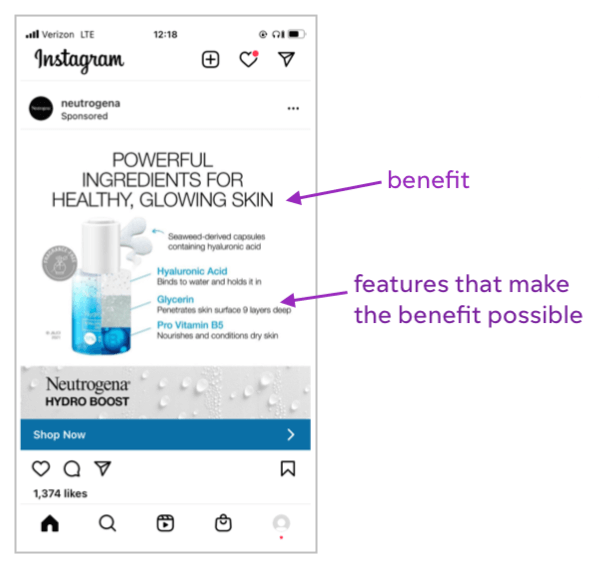
20. Relying on copywriting formulas too much
Tons of copywriting best practices are online for us to learn and use in texts. Based on other writers’ experience, these tips are great to use as a guideline or starting point.
But often, these copywriting formulas are just prevalent practices that worked for someone. Who said they would work for your readers?
Examples:
- They say: Odd numbers capture more attention. True, but it doesn’t mean even numbers will kill your copy’s engagement.
- They say: The word “free” is a surefire way to grab a reader. Maybe, but some people will see it as a signal of spam.
- They say: These headline formulas work. Let it be, but those formulas won’t rock if they don’t suit your audience or content strategy.
The point I’m trying to drive home is, it’s a mistake to believe and follow all copywriting formulas in your texts. Test them with your audience rather than assuming they will work for you because they worked for another copywriter.
21. Being too salesy
Online users are not naive or stupid. They understand your copy is about selling something, so they don’t need you to focus their attention on that. Too aggressive, direct selling messages in texts cause a backfire.
Rejection.
Instead, tell a story about your product, use testimonials from satisfied customers, and focus on appealing language to make the audience want what you have for them. A compelling call to action at the end of your content will be enough for readers to act.
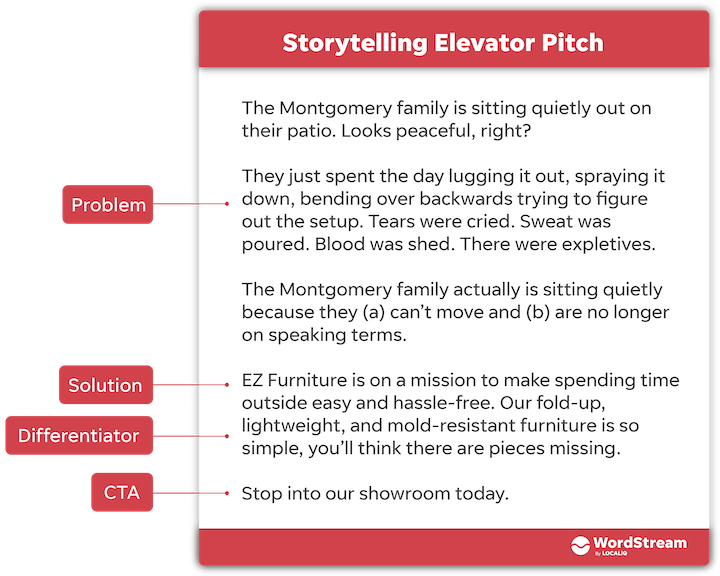
Use our elevator pitch templates to write convincing but not salesy content!
Keep your copywriting on the right track
So now you have it: the long list of copywriting mistakes. Make checking the above items a part of your editing routine. Ensure that all words, tone, and writing formulas in your copy make sense, serve a purpose, match your target audience, and drive your goals forward. Your audience (and business) will thank you for it!
About the author
Olesya Filipenko is a seasoned web writer creating informative and educational content for small and medium business websites’ blogs on digital marketing, content marketing, and creative writing. You can find her at WritingBreeze.com and on Twitter @WritingBreeze.


0 Comments